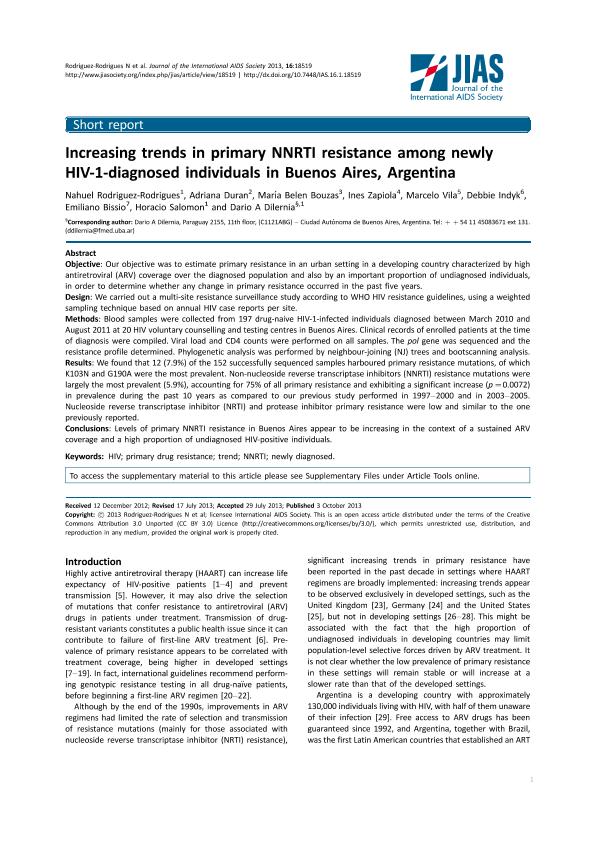Artículo
Increasing trends in primary NNRTI resistance among newly HIV-1-diagnosed individuals in Buenos Aires, Argentina
Rodriguez Rodrigues, Nahuel Emiliano ; Duran, Adriana; Bouzas, Maria Belen; Zapiola, Ines; Vila, Marcelo; Indyk, Debbie; Bissio, Emiliano; Salomon, Horacio Eduardo
; Duran, Adriana; Bouzas, Maria Belen; Zapiola, Ines; Vila, Marcelo; Indyk, Debbie; Bissio, Emiliano; Salomon, Horacio Eduardo ; Dilernia, Dario Alberto
; Dilernia, Dario Alberto
 ; Duran, Adriana; Bouzas, Maria Belen; Zapiola, Ines; Vila, Marcelo; Indyk, Debbie; Bissio, Emiliano; Salomon, Horacio Eduardo
; Duran, Adriana; Bouzas, Maria Belen; Zapiola, Ines; Vila, Marcelo; Indyk, Debbie; Bissio, Emiliano; Salomon, Horacio Eduardo ; Dilernia, Dario Alberto
; Dilernia, Dario Alberto
Fecha de publicación:
03/10/2013
Editorial:
International AIDS Society
Revista:
Journal of the International AIDS Society
ISSN:
1758-2652
Idioma:
Inglés
Tipo de recurso:
Artículo publicado
Clasificación temática:
Resumen
Objective: Our objective was to estimate primary resistance in an urban setting in a developing country characterized by high antiretroviral (ARV) coverage over the diagnosed population and also by an important proportion of undiagnosed individuals, in order to determine whether any change in primary resistance occurred in the past five years. Design: We carried out a multi-site resistance surveillance study according to WHO HIV resistance guidelines, using a weighted sampling technique based on annual HIV case reports per site. Methods: Blood samples were collected from 197 drug-naive HIV-1-infected individuals diagnosed between March 2010 and August 2011 at 20 HIV voluntary counselling and testing centres in Buenos Aires. Clinical records of enrolled patients at the time of diagnosis were compiled. Viral load and CD4 counts were performed on all samples. The pol gene was sequenced and the resistance profile determined. Phylogenetic analysis was performed by neighbour-joining (NJ) trees and bootscanning analysis. Results: We found that 12 (7.9%) of the 152 successfully sequenced samples harboured primary resistance mutations, of which K103N and G190A were the most prevalent. Non-nucleoside reverse transcriptase inhibitors (NNRTI) resistance mutations were largely the most prevalent (5.9%), accounting for 75% of all primary resistance and exhibiting a significant increase (p =0.0072) in prevalence during the past 10 years as compared to our previous study performed in 1997-2000 and in 2003-2005. Nucleoside reverse transcriptase inhibitor (NRTI) and protease inhibitor primary resistance were low and similar to the one previously reported. Conclusions: Levels of primary NNRTI resistance in Buenos Aires appear to be increasing in the context of a sustained ARV coverage and a high proportion of undiagnosed HIV-positive individuals. © 2013 Rodriguez-Rodrigues N et al; licensee International AIDS Society.
Palabras clave:
HIV
,
NEWLY DIAGNOSED
,
NNRTI
,
PRIMARY DRUG RESISTANCE
,
TREND
Archivos asociados
Licencia
Identificadores
Colecciones
Articulos(INBIRS)
Articulos de INSTITUTO DE INVESTIGACIONES BIOMEDICAS EN RETROVIRUS Y SIDA
Articulos de INSTITUTO DE INVESTIGACIONES BIOMEDICAS EN RETROVIRUS Y SIDA
Articulos(OCA HOUSSAY)
Articulos de OFICINA DE COORDINACION ADMINISTRATIVA HOUSSAY
Articulos de OFICINA DE COORDINACION ADMINISTRATIVA HOUSSAY
Citación
Rodriguez Rodrigues, Nahuel Emiliano; Duran, Adriana; Bouzas, Maria Belen; Zapiola, Ines; Vila, Marcelo; et al.; Increasing trends in primary NNRTI resistance among newly HIV-1-diagnosed individuals in Buenos Aires, Argentina; International AIDS Society; Journal of the International AIDS Society; 16; 3-10-2013; 1-6
Compartir
Altmétricas



